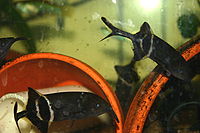- Peters' elephantnose fish
-
Elephantnose fish 
Two Gnathonemus petersii Scientific classification Kingdom: Animalia Phylum: Chordata Class: Actinopterygii Order: Osteoglossiformes Family: Mormyridae Genus: Gnathonemus Species: G. petersii Binomial name Gnathonemus petersii
(Günther, 1862)Peters' elephantnose fish (Gnathonemus petersii; syn. Gnathonemus brevicaudatus Pellegrin, 1919, Mormyrus petersii Günther, 1862[1]) is an elephantfish in the genus Gnathonemus. Other names in English include elephantnose fish, long-nosed elephant fish, and Ubangi mormyrid, after the Ubangi River. As the Latin name petersii confirms it is named after someone called "Peters" (probably Wilhelm Peters), although the apostrophe is often misplaced and the common name given as "Peter's elephantnose fish".
Contents
Description
Peters' elephantnose fish are native to the rivers of West and Central Africa, in particular the lower Niger River basin, the Ogun River basin and in the upper Chari River. It prefers muddy, slowly moving rivers and pools with cover such as submerged branches. It is a dark brown to black in colour, laterally compressed (averaging 23–25 cm), with a rear dorsal fin and anal fin of the same length. Its caudal or tail fin is forked. It has two stripes on its lower pendicular. Its most striking feature, as its names suggest, is a trunk-like protrusion on the head. This is not actually a nose, but a sensitive extension of the mouth, that it uses for self-defense, communication, navigation, and finding worms and insects to eat. This organ is covered in electroreceptors, as is much of the rest of its body. The elephantnose fish has poor eyesight and uses a weak electric field, which it generates by muscular contractions, to find food, to navigate in dark or turbid waters, and to find a mate. Peters' elephantnose fish live to about 6-10 years, but there are reports of them living even longer.
In the aquarium
Peters' elephantnose fish is probably the most commonly-available Mormyrid in aquarium stores in the USA. In the aquarium (which should be at least 200 liters) it is timid, preferring a heavily planted environment with subdued lighting. Ideally, a pipe or hollow log should be provided. The substrate should ideally be soft sand to allow the fish to sift through it with its delicate extended lip. It feeds on small worms (bloodworms) and aquatic invertebrates such as mosquito larvae, but in the aquarium will usually accept frozen or even flake food. How peaceful an elephantnose fish is can depend on the individual; some are quite aggressive with other species, while others are retiring. They may be kept in a community aquarium with peaceful species who share their water preferences. However, unless kept in an aquarium of over 400 liters, it is unwise to keep more than one elephantnose fish as they can be territorial. The conditions suggested to keep them in an aquarium are as follows: pH of 6.8 to 7.2, water temperature 26 to 28 degrees Celsius, and water of medium hardness. The substrate should always be something that does not irritate the sensitive snout of the fish.
The weak electrical impulses generated by this fish can be made audible by placing two electrodes in the fish tank, which are then hooked up to an audio amplifier or a piezoelectric earbud. The sonar-like clicks that this fish emits can sound like a squeaky door when the fish is excited.
See also
Notes
References
- Froese, Rainer, and Daniel Pauly, eds. (2006). "Gnathonemus petersii" in FishBase. May 2006 version.
External links
- Peter Cain and Sapna Malwal, Landmark use and development of navigation behaviour in the weakly electric fish Gnathonemus petersii (Mormyridae; Teleostei), Journal of Experimental Biology, 205, 3915-3923 (2002), [1]
- Photo (BBC News)
- [2] Sci-toys.com instructions on making elephant nose electrical emissions audible.
Categories:- Mormyridae
- Weakly electric fish
Wikimedia Foundation. 2010.

